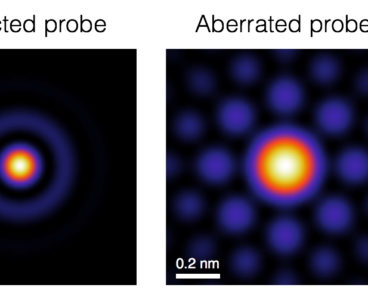Realization of “3D printing” material assembly on the micron or even nanometer scale has posed significant challenges to researchers. Now, scientists have developed a specialized computer simulation that guides an electron beam to create custom 3D structures (ACS Nano, “Simulation guided 3D nanomanufacturing via focused electron beam induced deposition”). The beam induces a precursor material…
Nano-spike Converts Greenhouse Gas to Fuel
In a new twist to waste-to-fuel technology, scientists at the Department of Energy’s Oak Ridge National Laboratory have developed an electrochemical process that uses tiny spikes of carbon and copper to turn carbon dioxide, a greenhouse gas, into ethanol. Their finding, which involves nanofabrication and catalysis science, was serendipitous. “We discovered somewhat by accident that…
Simulations Show How to Turn Graphene’s Defects into Assets
Researchers at Penn State, the Department of Energy’s Oak Ridge National Laboratory and Lockheed Martin Space Systems Company have developed methods to control defects in two-dimensional materials, such as graphene, that may lead to improved membranes for water desalination, energy storage, sensing or advanced protective coatings. For a two-dimensional, one-atom-thick material like graphene, defects such as small…
Unlocking Potential of 3D Printed Rocket Parts with Neutrinos
Neutrons Used to Create NASA’s 3D Printed Rocket Parts
The process of 3D printing, or additive manufacturing, holds promise for advancements in almost every industry, including even rocket science. Engineers from NASA’s Marshall Space Flight Center in Huntsville, Ala., used neutrons recently to help understand the potential benefit of additive manufactured rocket engine components. The team used the Neutron Residual Stress Mapping Facility at…
Incredible Microprocessor Behavior Pushes Boundaries of Silicon Chips
Researchers studying the behavior of nanoscale materials at the Department of Energy’s Oak Ridge National Laboratory have uncovered remarkable behavior that could advance microprocessors beyond today’s silicon-based chips. The study, featured on the cover of Advanced Electronic Materials, shows that a single crystal complex oxide material, when confined to micro- and nanoscales, can act like…
New Electron Microscope Method Detects Atomic-Scale Magnetism
Scientists can now detect magnetic behavior at the atomic level with a new electron microscopy technique developed by a team from the Department of Energy’s Oak Ridge National Laboratory and Uppsala University, Sweden. The researchers took a counterintuitive approach by taking advantage of optical distortions that they typically try to eliminate. “It’s a new approach…



